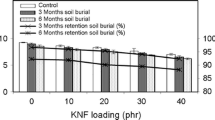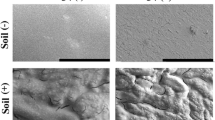Abstract
Polyethylene degrades slowly when discarded in the environment and exposed to natural weathering. A solution to this problem is the incorporation of additives to accelerate its biodegradation. In the present study, a biodegradable low-density polyethylene (LDPE) blend was obtained by the mixture of LDPE with a biodegrading additive (8% w/w) and the effect of accelerated weathering on biodegradation process was assessed. Chemical, mechanical, thermal, and morphological properties of non-aged and aged samples were studied. Results showed that aging process caused changes on structural characteristics (insertion of functional groups), morphological (appearance of micro-cracks and increased roughness), mechanical (greater stiffness and loss of plasticity) and thermal (lower degree of crystallinity and thermal stability) properties. The presence of biodegrading additive contributed to aging process, since polar functional groups were inserted into additive exposed to soil underwent greater degradation than their non-aged counterparts. CO2 production of aged LDPE blend demonstrated that accelerated weathering influences biodegradation process. In this work, due to availability of O2 gas, aerobic microorganisms can be the main responsible by the material deterioration, leading to production of microbial biomass, CO2 and H2O. Thus, the results of biodegradation (166 days) obtained in this work are promising, once it was reached a natural soil from South Brazil landfill.







Similar content being viewed by others
References
Santo M, Weitsman R, Sivan A (2013) The role of the copper-binding enzyme—laccase—in the biodegradation of polyethylene by the actinomycete Rhodococcus ruber. Int Biodeter Biodeg 84:204–210
PeixotoJ SL, Krüger R (2017) Brazilian Cerrado soil reveals an untapped microbial potential for unpretreated polyethylene biodegradation. J Hazard Mater 324B:634–644
Silva E, Neto J (2016) Impactos Ambientais da produção de garrafas de polietileno numa indústria de Teresina. Polimeros 26:49–54
Adelhafidi A, Babaghayou I, Chabira S, Sebaa M (2015) Spectroscopic analysis of weathering effects on low density polyethylene. J Chem Eng Chem Res 2:529–535
Sen S, Raut S (2015) Microbial degradation of low density polyethylene (LDPE): a review. J Environ Chem Eng 3:462–473
Scott G (2000) Green polymers. Polym Degrad Stabil 68:1–7
Ojeda T, Dalmolin E, Forte M, Jacques R, Bento F, Camargo F (2009) Abiotic and biotic degradation of oxo-biodegradable polyethylenes. Polym Degrad Stabil 94:965–970
Martínez-Romo A, González-Mota R, Soto-Bernal J, Rosales-Candelas I (2015) Investigating the degradability of HDPE, LDPE, PE-BIO, and PE-OXO films under UV-B radiation. J Spectrosc 10:1–6
Haider T, Völker C, Kramm J, Landfester K, Wurm F (2019) Plastics of the future? The impact of biodegradable polymers on the environment and on society. Angew Chem Int Ed58:50–62
Morro A, Catalina F, Sanchez-León E, Abrusci C (2019) Photodegradation and biodegradation under thermophile conditions of mulching films based on poly (butylene adipate-coterephthalate) and its blend with poly (lactic acid). J Polym Environ 27:352–363
Shah A, Hasan F, Hameed A, Ahmed S (2008) Biological degradation of plastics: a comprehensive review. Biotechnol Adv 26:246–265
Esmaeli A, Pourbabaee A, Alikhani H, Shabani F, Esmaeli E (2013) Biodegradation of low-density polyethylene (LDPE) by mixed culture of Lysinibacillus xylanilyticus and Aspergillus niger in soil. PLoS ONE 8e:71720
Yang J, Yang Y, Wu W, Zhao J, Jiang L (2014) Evidence of polyethylene biodegradation by bacterial strains from the guts of plastic-eating wax worms. Environ Sci Technol 48:13776–13784
Ojeda T, Freitasb A, Birck K, Dalmolin E, Jacques R, Bento F, Camargo F (2011) Degradability of linear polyolefins under natural weathering. Polym Degrad Stabil 96:703–707
Albertsson A, Kalrsson S (1994) Environment-adaptable polymers. Polym Degrad Stabil 41:345–349
Gewert B, Plassmann M, Macleod M (2015) Pathways for degradation of plastic polymers floating in the marine environment. Environ Sci Proc Imp 17:1513–1521
Raddadi N, Fava F (2019) Biodegradation of oil-based plastics in the environment: existing knowledge and needs of research and innovation. Sci Total Environ 679:148–158
Fontanella S, Bonhomme S, Kounty M, Husarova L, Brusson JM, Courdavaulti JP, Pitterif S, Samuelg G, Pichonh G, Lemairea J, Delort AM (2010) Comparison of the biodegradability of various polyethylene films containing pro-oxidant additives. Polym Degrad Stabil 95:1011–1021
Nowak B, Pajak J, Drozd-Brarkowicz M, Rymarz G (2011) Microorganisms participating in the biodegradation of modified polyethylene films in different soils under laboratory conditions. Int Biodeter Biodeg 65:757–767
Corti A, Sudhakar M, Chiellini E (2012) Assessment of the whole environment degradation of oxo-biodegradable linear low density polyethylene (LLDPE) films designed for mulching applications. J Polym Environ 20:1007–1018
Richter M, Schulenburg C, Jankowska D, Heck T, Faccio G (2015) Novel materials through nature’s catalysts. Mater Today 18:459–467
Pires J, Miranda G, de Souza G, Fraga F, Ramos A, de Araújo G, Ligabue R, Azevedo C, Lourega R, de Lima J (2019) Investigation of degradation of polypropylene in soil from enzymatic additive. Iran Polym J 28:1045–1055
Pires J, Ramos A, Miranda G, de Souza G, Fraga F, Azevedo C, Ligabue R, de Lima J, Lourega R (2020) Natural freshwater degradation of polypropylene blends with additives of a distinct nature. Polym Bull published online
Dartora P, Santana R, Moreira A (2015) The influence of the long chain branches of LLDPE on processability and physical properties. Polimeros 25:531–539
Barbeş L, Rădulescu C, Stihi C (2014) Spectrometry characterization of polymeric materials. Rom Rep Phys 66:765–777
Tavares C, Gulmine J, Lepienski C, Akcelrud L (2003) The effect of accelerated aging on the surface mechanical properties of polyethylene. Polym Degrad Stabil 81:367–373
Gulmine J, Janissek P, Heise H, Akcelrud L (2003) Degradation profile of polyethylene after artificial accelerated weathering. Polym Degrad Stabil 79:385–397
Ndlovu S, Van Reenen A, Luyt A (2013) LDPE-wood composites utilizing degraded LDPE as compatibilizer. Compos A 51:80–88
Restrepo-Flórez JM, Bassi A, Thompson M (2014) Microbial degradation and deterioration of polyethylene—a review. Int Biodet Biodeg 88:83–90
Reddy M, Gupta R, Bhattacharya S, Parthasarathy R (2008) Abiotic oxidation studies of oxi-degradable polyethylene. J Polym Environ 16:27–34
Lucas E, Soares B, Monteiro E (2001) Caracterização de polímeros—determinação de peso molecular e análise térmica. E-papers, Rio de Janeiro
Pedroso A, Rosa D (2005) Mechanical, thermal and morphological characterization of recycled LDPE/corn starch blends. Carbohyd Polym 59:1–9
Vogt N, Kleppe E (2009) Oxo-biodegradable polyolefins show continued and increased thermal oxidative degradation after exposure to light. Polym Degrad Stabil 94:659–663
Benítez A, Sánchez J, Arnal M, Müller A (2013) Monitoring abiotic degradation of branched polyethylenes formulated with pro-oxidant through different mechanical tests. Polym Degrad Stabil 98:1705–1716
Benítez A, Sánchez J, Arnal M, Müller A, Rodríguez O, Morales G (2013) Abiotic degradation of LDPE and LLDPE formulated with pro-oxidant additive. Polym Degrad Stabil 98:490–501
Lucas N, Bienaime C, Belloy C, Queneudec M, Silvestre F, Nava-Saucedo JE (2008) Polymer biodegradation: mechanisms and estimation techniques-a review. Chemosphere 73:429–444
Albertsson A, Barenstedt C, Karlsson S, Lindberg T (1995) Degradation product pattern and morphology changes as means to differentiate abiotically and biotically aged degradable polyethylene. Polymer 36:3075–3083
Ojha N, Pradhan N, Singh S, Barla A, Shrivastava A, Khatua P, Rai V, Bose S (2017) Evaluation of HDPE and LDPE degradation by fungus, implemented by statistical optimization. Sci Rep-UK 7:1–13
Teymouri Y, Kwamen R, Blümich B (2015) Aging and degradation of LDPE by compact NMR. Macromol Mater Eng 300:1063–1070
Castro-Aguirre E, Auras R, Selke S, Rubino M, Marsh T (2017) Insights on the aerobic biodegradation of polymers by analysis of evolved carbon dioxide in simulated composting conditions. Polym Degrad Stabil 137:251–271
Gu JD (2003) Microbiological deterioration and biodegradation of synthetic polymeric materials: recent research advances. Int Biodeter Biodeg 52:69–91
Nguyen DM, Do TVV, Grillet AC, Thuc HH, Nhan C, Thuc H (2016) Biodegradability of polymer film based on low density polyethylene and cassava starch. Int Biodeterior Biodegradation 115:257–265
Acknowledgements
The authors thank CAPES (Financial Code—001) for scholarships, as well as PUCRS and Brasilata Company for technical and financial support, Laboratório Central de Microscopia e Microanálise (LabCEMM/PUCRS) for morphological analyzes and Laboratory of Dr. Marcelo Villar (PLAPIQUI/CONICET) for the GPC analyses.
Author information
Authors and Affiliations
Corresponding author
Rights and permissions
About this article
Cite this article
Miranda, G., Pires, J., Souza, G. et al. Abiotic and biotic degradations of a LDPE blend in soil of South Brazil landfill. Iran Polym J 29, 1123–1135 (2020). https://doi.org/10.1007/s13726-020-00866-w
Received:
Accepted:
Published:
Issue Date:
DOI: https://doi.org/10.1007/s13726-020-00866-w




